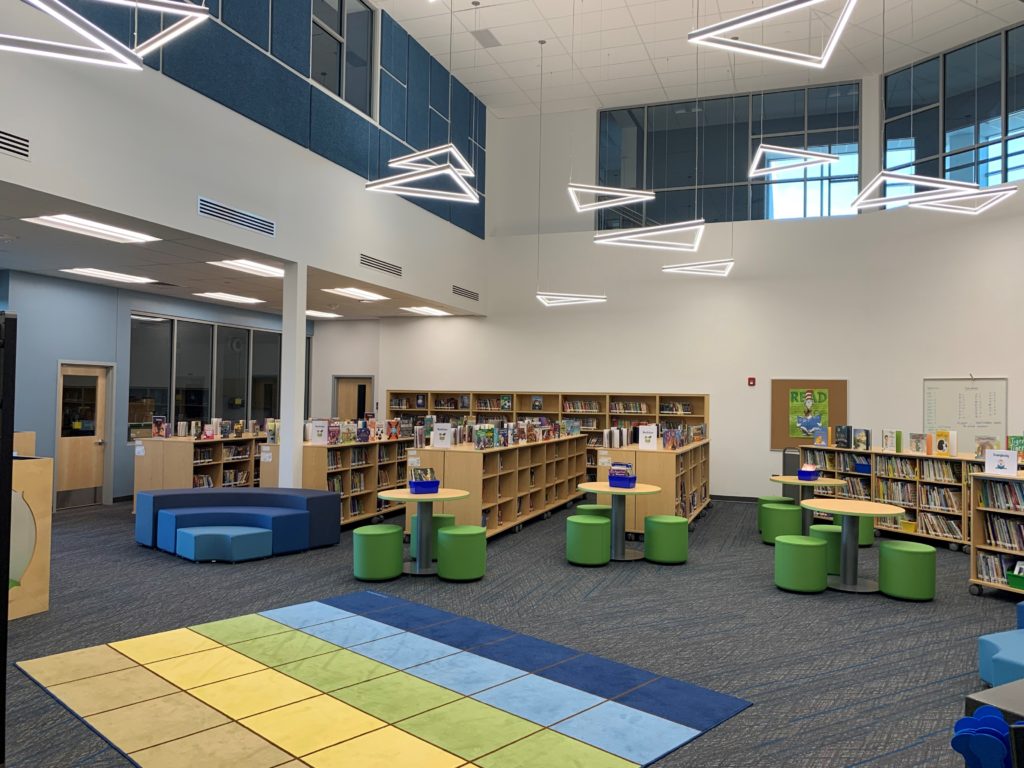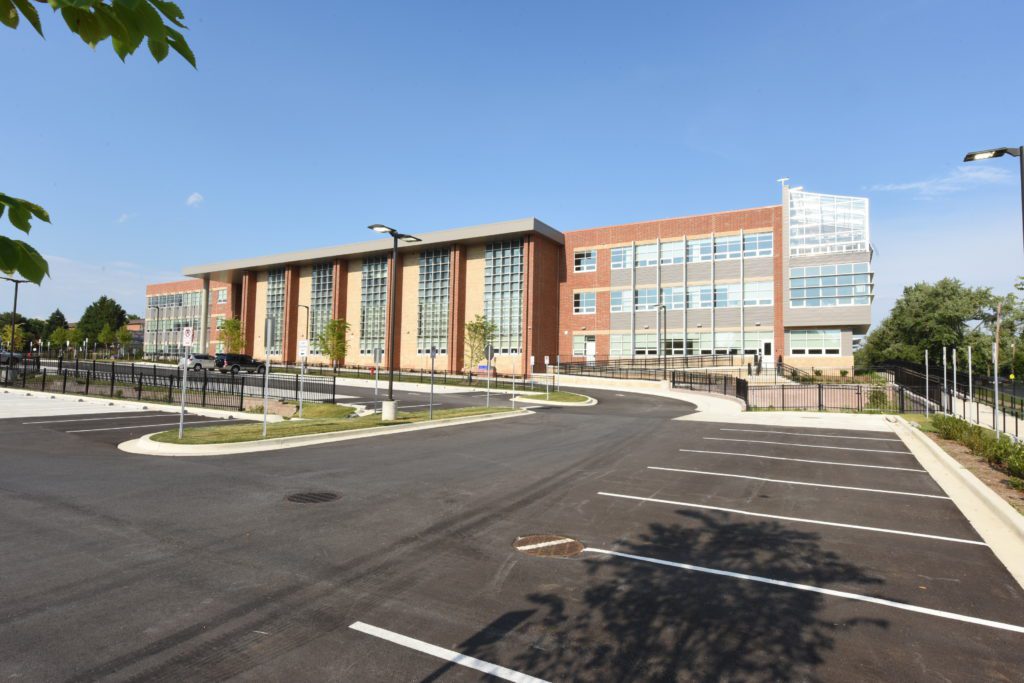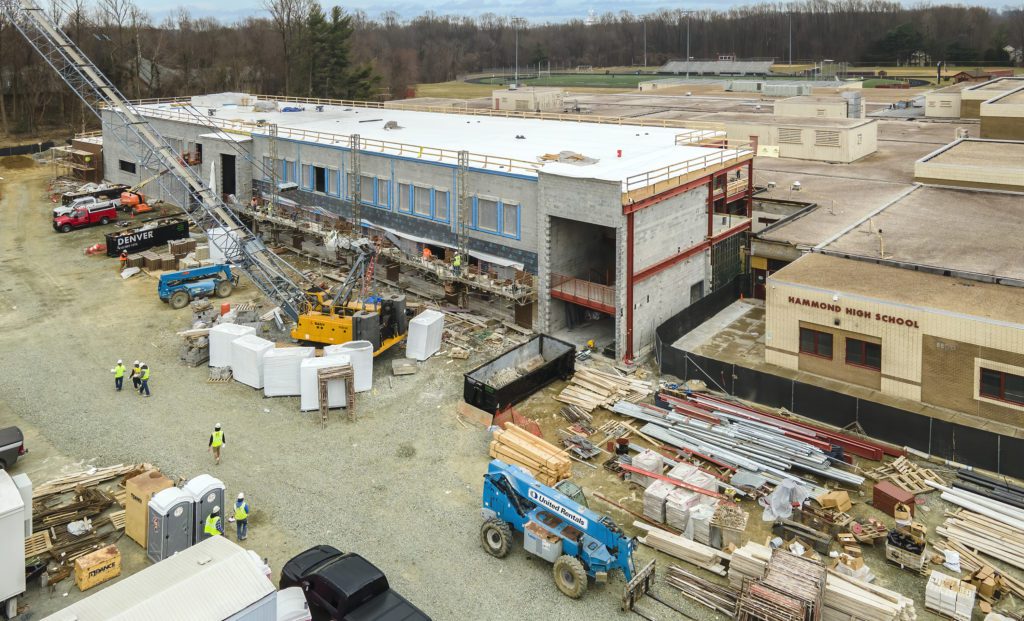Making the Grade
School construction teams tackle modern designs, massive renovations
From collaborative breakout classrooms to high-tech career training workshops to significantly different standards for security, new schools in Maryland are aiming to create dynamic, engaging learning environments. Realizing that vision, however, can require designers to fit bold new ideas in limited, economical spaces and builders to execute construction plans that sometimes feel like mammoth Jenga puzzles.

“Several counties have been creating centralized, collaborative spaces that allow a classroom or two of students to meet in the center of the building,” said Brian Minnich, Associate at GWWO Architects.
From elementary schools to high schools GWWO’s designs have shown those flexible spaces facilitate varied teaching styles and activities while also satisfying the need of many school systems to create more compact schools.
In Frederick County, the newly completed prototype elementary school, Blue Heron Elementary, includes a bright, colorful collaborative learning space about the media center and smaller breakout areas between classrooms. Working on limited budgets, school systems have been looking for ways to optimize school space. At Blue Heron, that included combining the gymnasium and cafeteria in one space, equipped with a moveable partition wall.
“At first, I was skeptical of the combination of the gym and the cafeteria,” said Dave Toth, Senior Project Manager at Oak Contracting. “But when I saw the doors open and how they could use that space collaboratively, I thought it turned out to be a great feature. It allows them to bring the whole school together for assemblies but also divide the space for daily use.”
Project teams on school renovation or construction projects are adjusting to other, fundamental design changes.

“One of the biggest changes we have seen is around security,” Minnich said. “Recently, the State of Maryland published a guideline on reducing child sex offenses which encourages visibility and transparency throughout the building. They want you to be able to see in and out of classrooms so there aren’t places where someone could hide and take advantage of a student. Before, people were reluctant to have transparency due to the focus on active shooters. But that’s not the only safety concern in schools so now we are seeing the focus shift to a whole-hazard approach to school safety.”
New security guidelines, he added, call for ways to quickly cover glazing around classrooms in the event of an active shooter.
Visibility is being used to achieve other goals in some new Maryland schools. Many high schools are using visibility and unconventional design “to shift the paradigm of Career and Technology Education classrooms,” Minnich said.
Rather than secluding wood shops and other CTE spaces in a separate area, “the CTE classrooms are being placed right next to the math classrooms and English classrooms, allowing for more interdisciplinary education and greater [CTE] visibility to students who may never have considered them,” he said.
Furthermore, CTE spaces will be designed to accommodate heftier technology demands — such as flight simulators, indoor drone flights, construction technology and biomedical engineering classes — and to support changing CTE programs in the future.
Executing modern educational design in a new school is challenging. Creating it within a decades-old structure pushes the challenge to a new level.

At Hammond High School in Howard County, J. Vinton Schafer & Sons Project Executive Tom Kraft is part way through a three-year, $77 million, occupied renovation.
“It includes 11 phases for the building, nine phases for the site and is one of the most complicated projects I have ever been part of. It feels like a giant Jenga puzzle,” Kraft said. “As the construction manager on the job, we got involved two years before any boots hit the ground to figure out the best approach to phasing.”
To create a modern educational environment, the project will change nearly every part of the 1970s school, demolish part of it, build an addition, expand the total size from 196,843 to 238,585 square feet, and increase school capacity by 200 students.
“We are working multiple shifts covering up to 20 hours per day up to 6 days per week,” Kraft said.
Consequently, the challenges facing the project team include installing all new electrical and HVAC systems in existing space and temporarily operating both old and new systems, adding new structural steel to the old building to support daylighting measures, and swiftly addressing mid-project surprises, such as sewer lines that are sloped the wrong way and old building sections that aren’t plumb, level and square.
“We are absolutely seeing a trend of redeveloping more existing school sites,” said Chris Marschhauser, Senior Project Manager at Oak Contracting. Given Central Maryland’s dense and growing population, “just about every school project we do is in a highly densely populated neighborhood and we are restricted in what we can do on that site.”
Oak Contracting, for example, was hired to build the new 400,000-square-foot Wheaton High School and 180,000-square-foot Thomas Edison High School of Technology in Montgomery County on the tight site that already housed both schools. Furthermore, construction could not interfere with ongoing classes for both schools, normal operations of an adjacent county park and swimming pool, or infrastructure supporting a cell tower just 30 feet from the property line.
The project required crews to overcome challenges such as “how do you take down half a building, leave the other half up and fully functioning for students, then install sheeting and shoring so you can excavate and start building the new school,” Marschhauser said.
Those extraordinarily complex renovations, however, are yielding stunning results.
As schools prepared to open this fall, J. Vinton Schafer wrapped up the final details on the new Edgewater Elementary School in Anne Arundel County. The five-phase, 2.5-year occupied renovation transformed the school layout, included a new addition, and gave students a new media center, gym, cafeteria and other spaces.
“You wouldn’t even recognize it as the same school that was here before,” said Tom Weaver, Project Manager at J. Vinton Schafer.
